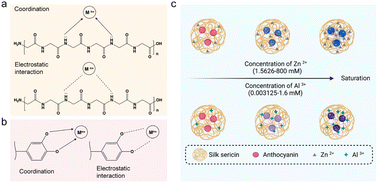Fabrication of silk sericin–anthocyanin nanocoating for chelating and saturation-visualization detection of metal ions†
Abstract
Silk sericin (SS) is a natural water-soluble protein with the potential to chelate metal ions via its polar groups. However, the difficulty of identifying the saturation of SS limits its application as filter films. One solution is to construct SS filter films with an indicator to reflect the degree of saturation of silk sericin. Hence, the nanocoating consisting of co-assembled SS protein and anthocyanin (C3G) nanoparticles is designed, constructed, and characterized to chelate metal ions with a saturation-visualization detection behavior. Here, metal ions Zn2+ and Al3+ are chosen as models to explore the chelating ability of SS and indicator behaviors of C3G, which could indicate the saturation degree of SS. Interestingly, after the saturation of SS in the solution and filter film situations, the visible color progressively shifts from pink to blue (Zn2+) or violet (Al3+), with the corresponding redshift of UV-Vis absorbance of C3G. Remarkable removal effectiveness of Zn2+ and Al3+, namely 93.16% and 53.97%, as well as an evident saturation-visualization detection, were identified by filter paper films with the nanocoating. Our research provides a fresh viewpoint for designing SS filter films that could effectively remove metal ions while enabling real-time viewing.

- This article is part of the themed collection: Design and function of materials nanoarchitectonics


 Please wait while we load your content...
Please wait while we load your content...